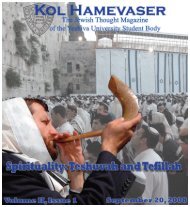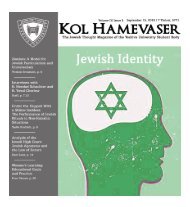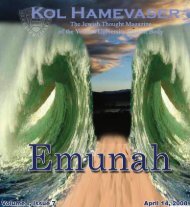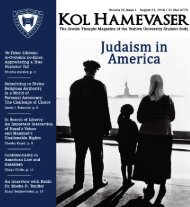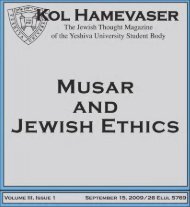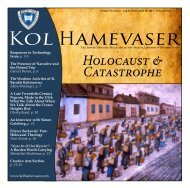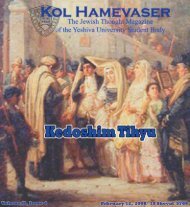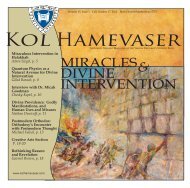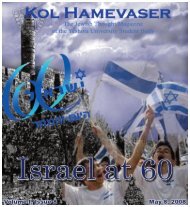Create successful ePaper yourself
Turn your PDF publications into a flip-book with our unique Google optimized e-Paper software.
lished) blessing before pre-Amidah piyyutim.<br />
It included a full set of piyyutim for Shaharit,<br />
Amidah, Kedushah <strong>and</strong> Musaf (depending on<br />
the occasion) by Palestinian <strong>and</strong> German authors.<br />
This early Ashkenazic rite remained in<br />
use in Germany (west of the Elbe River),<br />
Switzerl<strong>and</strong>, Holl<strong>and</strong>, Belgium, northern<br />
France <strong>and</strong> some communities in northern<br />
Italy.<br />
An additional codification of prayers was<br />
that of Rambam. His prayer rite was designed<br />
to combine the Sephardic liturgy that he knew<br />
with his halakhic rulings. Based on an early<br />
Sephardic nussah <strong>and</strong> deviating from the<br />
Geonic tradition of Sa’adyah, Maimonides’<br />
liturgy had its greatest effect in Yemen where<br />
it was basically adopted in two versions to<br />
which we will return below.<br />
Thus, by the early Middle Ages, the Palestinian<br />
nussah had spawned the Romaniot, Italian<br />
<strong>and</strong> early Ashkenazic rites, while the<br />
Babylonian rite had generated the early<br />
Sephardic liturgy <strong>and</strong> a<br />
Maimonidean/Yemenite rite. None of these<br />
nusha’ot was free of the influence of the others,<br />
especially as a result of halakhic debate in<br />
the emerging <strong>and</strong> constantly growing literature<br />
of posekim (decisors), mefareshim (commentators)<br />
<strong>and</strong> teshuvot (responsa).<br />
Thus far, we have been assuming the classification<br />
of nussah ha-tefillah into two main<br />
groups: Palestinian <strong>and</strong> Babylonian. But this<br />
is true only regarding the influence of Pales-<br />
<strong>Halakhah</strong> <strong>and</strong> <strong>Minhag</strong><br />
tinian piyyut or its absence. By the early Middle<br />
Ages, almost all communities (Italy <strong>and</strong><br />
Iran possibly excepted) followed the Babylonian<br />
statutory prayers in some form or other <strong>and</strong><br />
the one-year Torah cycle, rather than the Palestinian<br />
triennial cycle. Nonetheless, Palestinian<br />
influence survived in the areas listed above, especially<br />
in elements incorporated together with<br />
holiday piyyut, such as the Ashkenazic recital<br />
of “oseh ha-shalom” <strong>and</strong> “le-eila le-eila” on<br />
the High Holy Days.<br />
While by this time Hellenistic Jewish<br />
prayer rites, if they existed at all, had already<br />
fallen away, as mentioned above, we can assume<br />
that Jews on the fringes of the main Jewish<br />
communities had their own liturgies. This<br />
is certainly the case with the Persian rite that<br />
must have developed in medieval times, which<br />
assimilated earlier poetic texts <strong>and</strong> versions of<br />
statutory prayers. Regarding choice of liturgical<br />
poetry to accompany the statutory rites,<br />
great divergence in local custom was extremely<br />
common throughout the Jewish world.<br />
An example of such a local rite is that of<br />
Comtat Venaissin in Provence. This nussah<br />
was used in just four towns: Avignon, Carpentras<br />
, L’Isle sur la Sorgue <strong>and</strong> Cavaillon. It is<br />
mostly like the Sephardic ritual but has influences<br />
from the northern French Ashkenazic<br />
tradition. The liturgy uses Nekaddesh, Na’aritsekha<br />
<strong>and</strong> Keter during various Kedushot,<br />
<strong>and</strong> “Shalom Rav” appears in the last blessing<br />
of all Amidot. In fact, however, while the statu-<br />
tory prayers were similar in these four towns,<br />
the piyyutim differed, showing that even close<br />
proximity <strong>and</strong> a common minhag did not prevent<br />
the rise of mahazorim with different poetic<br />
insertions. This rite fell into disuse in the<br />
19 th century <strong>and</strong> is probably typical of numerous<br />
early Ashkenazic <strong>and</strong> Sephardic nusha’ot<br />
that were never clearly delimited <strong>and</strong> are no<br />
longer practiced. Some other such rites, besides<br />
the Persian that we mentioned above, are<br />
the Aleppo liturgy, which is close to Persian<br />
rite but has some Palestinian influences, <strong>and</strong><br />
the versions of Indian rites distinguished from<br />
the Iraqi nussah by their piyyutim.<br />
Let us return now to trace the evolution of<br />
the three main rites we are discussing: Ashkenazic,<br />
Sephardic <strong>and</strong> Maimonidian/Yemenite.<br />
The Ashkenazic liturgy as it was brought<br />
to Germany from Italy with an admixture of<br />
Geonic influence, especially from the Seder<br />
Rav Amram, formed only the basis of the fully<br />
Chart designed by the author<br />
developed rite <strong>and</strong> thus can be called proto-<br />
Ashkenazic, as mentioned above. In the 14 th<br />
century, the textual <strong>and</strong> halakhic aspects of<br />
minhag Ashkenaz were st<strong>and</strong>ardized by R.<br />
Jacob ben Moses Moellin (Maharil, c. 1360-<br />
1427) in Mainz. He <strong>and</strong> his circle, for the most<br />
part, produced the Ashkenazic siddur – not the<br />
one in use today but rather a version that did<br />
not yet reflect Kabbalistic influence or the editing<br />
of modern grammarians. This Ashkenazic<br />
rite then split at some point into western <strong>and</strong><br />
eastern branches – “German” <strong>and</strong> “Polish.”<br />
Volume III, Issue 7 www.kolhamevaser.com<br />
The Eastern branch was used in the eastern part<br />
of Germany, Pol<strong>and</strong>, Lithuania, Bohemia,<br />
Moravia, Hungary <strong>and</strong> the rest of Austria, Russia,<br />
Romania, <strong>and</strong> the rest of the Balkans. In<br />
matters of some piyyut <strong>and</strong> rituals for special<br />
occasions, like selihot <strong>and</strong> kinot (elegies), there<br />
is a further division into “German” (adopted in<br />
the Rhine River region), “Polish” (adopted in<br />
Austria <strong>and</strong> Bohemia) <strong>and</strong> “Lithuanian” versions.<br />
Local customs were so carefully preserved<br />
that thirteen or more versions of<br />
Ashkenazic selihot have been printed. These<br />
different Ashkenazic rites reflect the emerging<br />
geographical identities of European areas <strong>and</strong><br />
also the halakhic leadership of various Jewish<br />
communities. Meanwhile, France as a whole,<br />
<strong>and</strong> especially Alsace, continued to use a ritual<br />
similar to the proto-Ashkenazic one discussed<br />
above.<br />
When Lurianic Kabbalah began to exercise<br />
its influence, Eastern European versions<br />
of the Ashkenazic nussah assimilated it in the<br />
16 th century, the time when Pol<strong>and</strong> was a great<br />
religious, intellectual Jewish center. Hasidism<br />
would later intensify this process, so that the<br />
final product in most of today’s Ashkenazic<br />
prayer books has been termed by some<br />
“Pseudo-Sefarad,” containing a core of Ashkenazic<br />
rite with some added “Sefarad” elements<br />
(see below). Some German Jews, even those<br />
who had accepted innovations after Maharil,<br />
declined to adopt most of these changes <strong>and</strong><br />
continued western Ashkenazic prayer as it was.<br />
But most, <strong>and</strong> eventually all, western European<br />
rites accepted some Kabbalistic innovations<br />
such as the Kabbalat Shabbat service <strong>and</strong><br />
“Lekhah Dodi” (Go forth, my Beloved).<br />
Sephardic prayer books were radically affected<br />
by the rise of Lurianic Kabbalah. This<br />
movement influenced virtually all Jewish communities<br />
where pietists tried to follow the kavvanot<br />
(mystical prayer intentions) of the Ari<br />
(R. Isaac Luria, 1534-1572) <strong>and</strong> rabbis strove<br />
to have their communities employ a prayer<br />
book arranged in accord with Kabbalistic<br />
teachings, even if the worshipers themselves<br />
did not know Kabbalah. This resulted from the<br />
religious elite’s acceptance of Kabbalistic doctrine<br />
<strong>and</strong> its consequent belief that only prayer<br />
books conforming to this doctrine should be<br />
used. Thereafter, virtually all local rites were<br />
eliminated, the Persian being a good example,<br />
<strong>and</strong> all Oriental communities adopted this new<br />
version of the Sephardic nussah. The Spanish-<br />
Portuguese liturgy, in Amsterdam <strong>and</strong> elsewhere<br />
following the expulsion from Spain,<br />
maintained a version of the mostly pre-Kabbalastic<br />
siddur which is used until today, although<br />
it, too, adopted Kabbalat Shabbat,<br />
“Lekhah Dodi” <strong>and</strong> some other changes. viii<br />
The confrontation between Lurianic Kabbalah<br />
<strong>and</strong> the Maimonidean <strong>Halakhah</strong> <strong>and</strong><br />
liturgy in Yemen caused a major controversy<br />
still being argued over today. Two versions,<br />
“Baladi” (traditional Yemenite) <strong>and</strong> “Shami”<br />
(Syrian), developed. Baladi refused most Kabbalistic<br />
innovation as heresy, while the Shami<br />
received a strong Kabbalistic overlay.<br />
In the aftermath of the Lurianic influence,<br />
we now have the following main rites: western<br />
Ashkenazic, eastern Ashkenazic (with Kabbal-<br />
9



